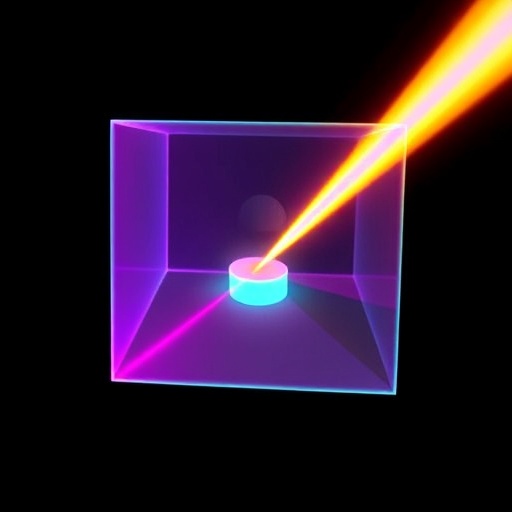In an exciting development within the realm of terahertz (THz) technology, a groundbreaking study led by Josh Caldwell, a distinguished professor of mechanical engineering at Vanderbilt University, has unveiled a novel method for effectively confining THz light to nanoscale dimensions. This innovative research, conducted in collaboration with Alex Paarmann from the Fritz Haber Institute and Prof. Lukas M. Eng from the Technische Universität Dresden, marks a significant milestone in the journey towards advancing opto-electronic devices. The results of this research, published in the esteemed journal Nature Materials, demonstrate that the integration of cutting-edge materials can lead to transformative applications in fields ranging from infrared emitters utilized in remote controls to sophisticated terahertz optics for environmental sensing and physical security.
At the core of this groundbreaking study is the utilization of hafnium dichalcogenides, a new class of layered materials composed of hafnium and chalcogen elements, such as sulfur and selenium. The research team focused on a unique quasiparticle known as phonon polaritons, which arise from the coupling of photons with the lattice vibrations within a crystal. This coupling phenomenon allowed the researchers to achieve unprecedented levels of confinement for THz light, compressing its wavelengths, which typically exceed 50 microns, to dimensions below 250 nanometers. This remarkable achievement was accomplished while minimizing energy loss, signaling a potential breakthrough in developing energy-efficient THz devices that could reshape various industries.
Caldwell likened the transformation of THz light confinement to a dramatic analogy: compressing light waves akin to confining ocean waves into a teacup. Such a significant reduction in wavelength has profound implications for the future of compact THz technology, which often struggles with large-scale integration due to constraints imposed by traditional materials. The team’s findings challenge the prevailing assumptions about THz light confinement, indicating that fundamental changes can be harnessed to facilitate miniaturization without compromising performance.
The implications of the research extend far beyond academic curiosity. The team’s focus on exploring the interactions between light and matter at the nano to atomic scale has the potential to revolutionize nonlinear optics and the design of nanoscale optical components. Through these studies, the researchers are aiming to reveal how these interactions differ from those in bulk materials. The study delves into intricate details regarding the sub-diffractional confinement of light and the characteristics of novel optical and electronic materials, ultimately paving the way for innovations in opto-electronic integration.
This ambitious research project initially began as a summer undertaking for a high school student, quickly evolving into a pioneering initiative that captured the attention of scientists worldwide. Such unexpected breakthroughs underscore the importance of fostering collaborations between academic institutions and researchers across various domains. The collaborative effort between the Free Electron Laser user facility FELBE at the Helmholtz-Zentrum Dresden-Rossendorf and researchers from both the Fritz Haber Institute and Vanderbilt University emphasizes the invaluable role of interdisciplinary teamwork in driving scientific advancements.
An essential aspect of the research involved utilizing advanced imaging techniques through near-field optical microscopy. This cutting-edge technology provided the necessary nanoscale imaging capabilities essential for exploring the effects of ultra-high THz light compression via phonon polaritons. The results indicate that hafnium dichalcogenides can serve not only as promising platforms for THz applications but also as gateways to exploring new frontiers in light-matter coupling.
Should these findings translate into practical applications, the research could facilitate the design of ultra-compact THz resonators and waveguides, which are critical components for a myriad of applications, including environmental sensing and security imaging. The successful integration of these materials into van der Waals heterostructures—assemblies formed by stacking layers of two-dimensional materials—holds the promise of reinforcing the capabilities of 2D materials research, promoting innovative approaches towards nanoscale opto-electronic integration.
As the scientific community continues to explore the properties of hafnium dichalcogenides, new physics may emerge through ultra-strong or even deep-strong light-matter coupling. The implications of these discoveries reach beyond the immediate research; they pave the way for high-throughput materials screening techniques that could potentially identify even more effective materials for THz technology applications.
The publication of this research represents not just a validation of the team’s hard work but also a stepping stone towards applying theoretical discoveries in practical scenarios. As Paarmann aptly stated, the research underscores the vital question of how far one can push the envelope of THz technology. The future may be bright for opto-electronic integration, which will consequently transform how various industries approach the integration of novel materials into functional devices.
In conclusion, this collaborative research not only broadens our understanding of the interactions between light and matter at unprecedented scales but also encourages future innovations that can arise from this exciting field. As researchers continue to unravel the complexities of terahertz technology, it appears we are only beginning to scratch the surface of what is possible.
Subject of Research: The confinement of terahertz light using hafnium dichalcogenides.
Article Title: Ultraconfined terahertz phonon polaritons in hafnium dichalcogenides.
News Publication Date: 15-Sep-2025.
Web References: Research Article.
References: None at this moment.
Image Credits: Ryan Kowalski and Niclas Mueller.
Keywords
Terahertz technology, hafnium dichalcogenides, phonon polaritons, nanoscale confinement, opto-electronic devices.




